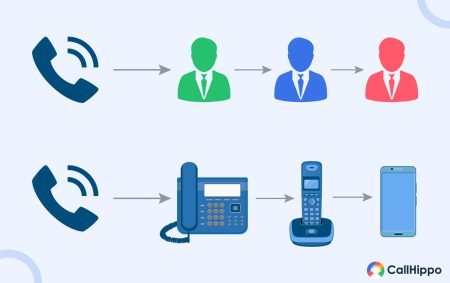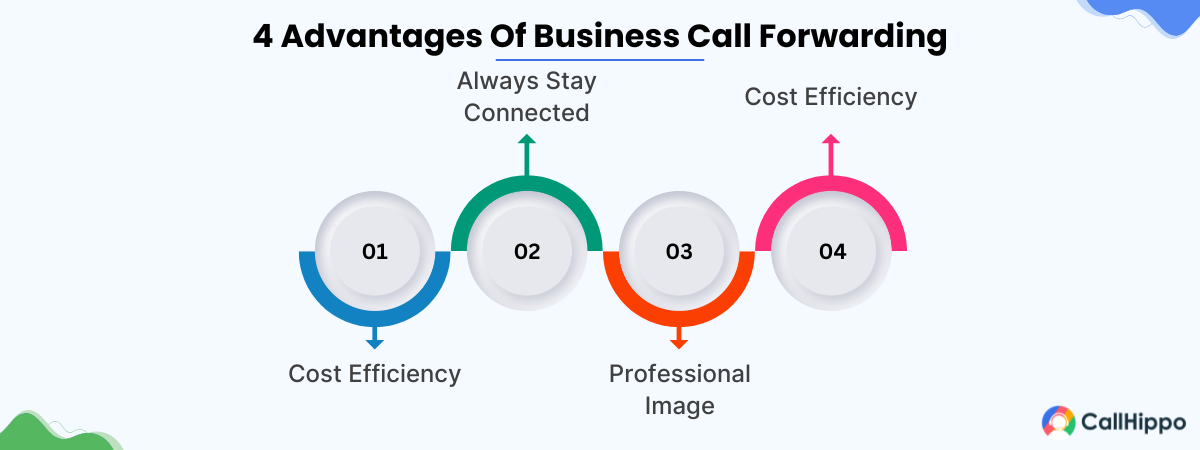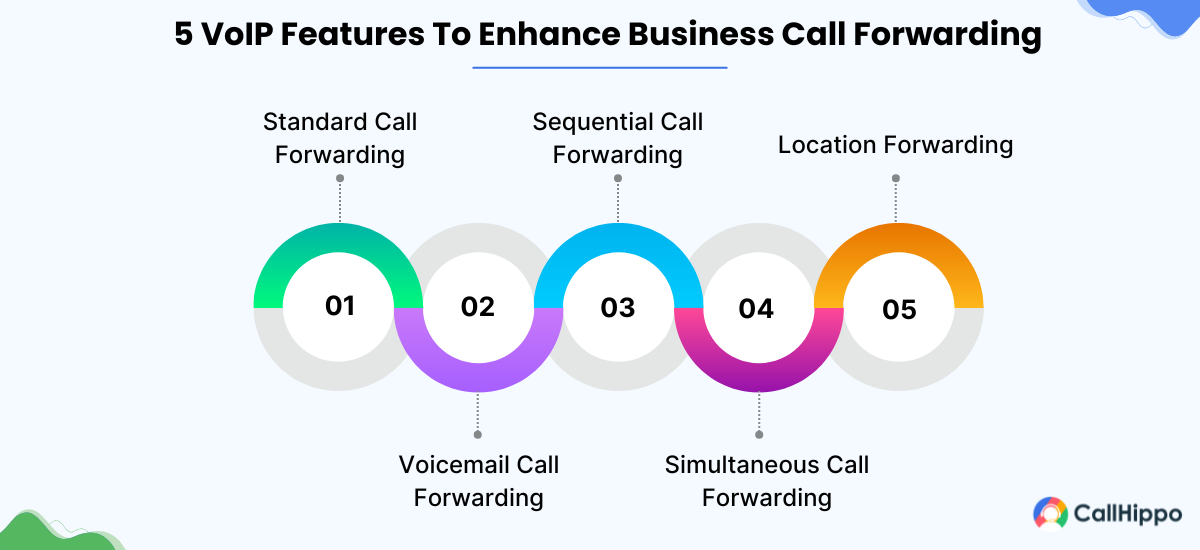Effective communication is essential, with most employees believing that communication influences how successfully they perform their tasks. As a small business owner, being busy can result in missed calls due to network issues or after-hours inquiries, leading to potential revenue loss.
This is where business call forwarding comes into play. It ensures that all calls are promptly answered, increasing customer satisfaction and overall efficiency. In this article, we will take a closer look at the benefits of business call forwarding and how you can set it up.
Invest in conference bridge technology to enhance remote communication in a cost-effective way. Make sure to check for integration capabilities and security features in your conference bridge service provider to enhance business communication.
What Is Business Call Forwarding?
Call forwarding is a pivotal feature in modern business phone systems, seamlessly redirecting incoming calls to designated destinations such as another phone number, mobile app, or voicemail system.
This flexibility ensures continuity and prevents the loss of critical customer calls, even when employees are unavailable or away from their desks. The system’s effectiveness comes from its ability to apply multiple rules of call forwarding for business, resulting in a sophisticated call routing system.
Calls can be routed to a mobile phone after hours, a voicemail system on holidays, or a colleague’s phone during business hours based on the time of day. This feature ensures accessibility anywhere by supporting a wide range of destinations, such as local numbers, mobile phones, virtual systems, international numbers, or auto attendants.
How Business Call Forwarding Works?

According to research, 67% of customers hang up the phone in frustration when they are unable to reach a customer service representative. This is primarily why and how call forwarding for business works. It routes a customer’s call from your business number to a team member who is available to assist at a predetermined number, such as a mobile device.
During this process, the provider’s outgoing call and the customer’s incoming call are connected to the selected endpoint and call routing options are tailored to availability. When a customer dials your business number, your phone system accepts the call, call management features determine the routing, and the call is routed to the appropriate person or department.
This is a multi-step visualization of the call-forwarding process. Call forwarding options, such as rules for forwarding calls when your main line is busy or routing calls to voicemail after hours, may influence their order. To facilitate a smooth transition, call forwarding settings can include on-hold music or a transfer tone.
Business phone call forwarding normally consists of three steps: receiving a call on your VoIP number, processing it according to your call forwarding rules, and connecting it to the chosen device or line. This method, which routes calls depending on a variety of parameters, is very beneficial in call centers.
How To Set Up Call Forwarding for Your Business?
Setting up business call forwarding on your cell phone can significantly improve your communication capabilities. Here’s how you can do it:
1. Understand Call Forwarding Options
Understanding the three most common call-forwarding options is critical for effective business communication. Unconditional call forwarding routes all calls to another number without your knowledge, ensuring constant accessibility. Busy call forwarding sends calls to a different number only when your line is busy, allowing for more efficient call management.
No answer call forwarding forwards calls when you do not answer after a predetermined number of rings, ensuring that important calls are not missed. Each option provides a unique approach to handling calls, allowing you to stay in touch with clients while effectively managing your time.
2. Set Up Unconditional Call Forwarding
To enable business call forwarding, you’ll probably need to enter a code on your phone followed by the forwarding number. For example, to enable unconditional call forwarding, dial *72 followed by the forwarding number. To turn it off, dial *73.
This feature ensures that all calls are seamlessly routed to the specified number without your phone ringing, which is especially useful in certain situations. Simply follow your service provider’s setup instructions to enable call forwarding and maintain smooth communication.
3. Implement Busy Call Forwarding
Dial the code your service provider provided and then the forwarding number to activate busy call forwarding. Professionals with hectic schedules who need to handle several calls at once will find this feature especially helpful as it only forwards calls when the line is busy.
4. Monitor and Adjust Call Forwarding Settings
Regularly monitoring your call forwarding usage is critical to ensuring that it meets your business requirements. You can change settings such as the forwarding number or disable call forwarding during specific times. This proactive approach optimizes communication, ensuring that you are always available to your clients.
What Are the Benefits of Business Call Forwarding?
When it comes down to the benefits of business phone number forwarding, the list is quite long. Some of the most common benefits include:

1. Enhanced Accessibility
Business call forwarding ensures that you are reachable at any time, from anywhere. Previously, being restricted to an office desk meant frequently missing calls. However, with the arrival of smartphones and broadband internet, calls can now follow you around without causing complications.
Your workplace phone number can be programmed to ring on your home or mobile phone when you’re working remotely or on the go. This ensures that you never miss critical contact with clients, coworkers, or business partners.
2. Professional Image
Maintaining a professional appearance is essential in the fiercely competitive business world of today. This is made possible by business phone number forwarding, which distinguishes calls that are personal from those that are work-related.
You can protect the privacy of your personal phone number by forwarding calls to a designated corporate number. This improves your time management and puts you in a more professional light, allowing you to focus on vital tasks uninterrupted.
3. Always Stay Connected
Business call forwarding enables you to stay in contact with your clients, colleagues, and business partners no matter where you are physically located. Whether you’re working from home or traveling for business, you can stay in contact with your clients and make sure that their needs are handled promptly.
This degree of closeness guarantees that you are always accessible, which promotes business expansion and permits you to uphold positive connections.
4. Cost Efficiency
In addition to its efficiency benefits, company call forwarding can assist save money. Call forwarding, which eliminates the need for expensive gear and several phone lines, can result in significant telecommunications savings.
Furthermore, business phone call forwarding can automate many parts of call handling, minimizing the need for extra personnel while enhancing operational efficiency.
VoIP Features That Enhance Business Call Forwarding
VoIP provides numerous features that significantly enhance business call-forwarding capabilities. These ultimately improve communication efficiency and customer service. Some of the most common features include:

1. Standard Call Forwarding
One vital feature that lets you divert incoming calls from one number to another is standard call forwarding. Businesses that use VoIP numbers or other virtual phone numbers that aren’t linked to actual phones would particularly benefit from it.
No matter where you are, you can be sure that all business calls will be immediately answered by setting up a call-forwarding number. This function is essential for upholding professionalism and accessibility in communication, making sure that your clients can reach you or a designated team member at all times.
2. Simultaneous Call Forwarding
Simultaneous call forwarding is a feature that routes incoming calls to multiple phone numbers at once. This capability is especially useful for firms where several team members or departments handle incoming calls.
Simultaneous call forwarding service for small business guarantees that calls are answered quickly, minimizing customer wait times and enhancing overall satisfaction. It also helps to spread call volume equitably across team members, increasing efficiency and productivity.
3. Sequential Call Forwarding
Sequential call forwarding, also referred to as “hunt group” or “follow-me” forwarding, forwards incoming calls to a list of phone numbers in a predefined order.
If the first number on the list is busy or does not answer, the call is automatically forwarded to the following number on the list, and so on. Calls are routed to the appropriate person or department with the help of this feature, improving call answer rates and decreasing missed incoming and unanswered calls, too.
4. Voicemail Call Forwarding
When the recipient is unavailable or does not answer after a specific
number of rings, incoming calls are routed to voicemail, allowing callers to leave messages. It can be activated at specific times, such as after business hours, to ensure important messages are captured.
This feature reduces missed calls, increasing customer satisfaction and communication efficiency by ensuring that no calls go unanswered.
5. Location Forwarding
During localized disruptions, “Location Forwarding” is particularly useful for businesses with many sites. You can use this business call forwarding function to reroute calls from one location to another, allowing customers to contact your personnel even if there is a problem at one site.
VoIP can be configured to redirect local calls to other offices with different local area codes, allowing you to maintain uninterrupted communication while minimizing the impact of disruptions on your company’s operations.
Conclusion
In order to maintain a professional image and ensure continuous connectivity, business call forwarding is a crucial part of modern business communication. It is essential for preventing missed calls and establishing easy communication with clients and coworkers.
Its appeal is further enhanced by its affordability, which makes it a feasible choice for companies of all sizes. By selecting a service that fulfills your unique communication requirements and works seamlessly with your current systems, you can guarantee constant connectivity and a polished appearance.
FAQs
1. How do I divert my business phone?
To divert the call, go to your business phone’s call or phone settings. Look for the option for call diversion or forwarding. After entering the phone number to which you want calls routed, save your adjustments. Make a call from a different phone to your business line to ensure it works.
2. How do I cancel call forwarding?
To stop call forwarding, go into your virtual phone system’s call settings or call settings once more. Locate and disable the call forwarding setting. You can preserve the adjustments, and your calls won’t be diverted to a different number.
3. What are the different types of call forwarding?
There are various kinds of forwarding phone calls. All calls are sent to a different number via unconditional forwarding, which doesn’t even ring your phone. Calls are only forwarded when you’re unavailable, busy, or out of range, according to conditional forwarding. You can forward calls from a different phone or location by using remote call forwarding.
4. How do I stop someone from calling my number?
If your phone has call-blocking tools, you can use them to prevent someone from phoning your number. Most cell phones include built-in tools for blocking specific numbers.

Subscribe to our newsletter & never miss our latest news and promotions.









